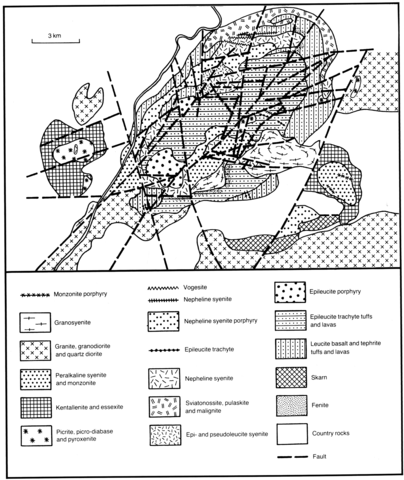stripes
This massif is located on the periphery of Cuba-Sadir mountain in Central Kazakhstan. It is a volcanic complex which is composed of extrusive and intrusive rocks. Among the extrusive and subvolcanic facies are leucite-bearing tephrites, augite porphyrites, leucite (pseudoleucite) porphyries, two phases of pseudoleucite trachyte porphyry and dykes of pseudoleucite tinguaite. Within the leucite suite phenocrysts are generally represented by pseudoleucite, which may reach three centimetres in diameter; rarely K-feldspar is present as phenocrysts. The fine-grained groundmass consists of microlites of feldspar, nepheline and altered glass. The earliest rocks of the intrusive facies consists of coarse- and medium-grained nepheline syenites within which is a weakly developed system of veins that is confined to the marginal areas of the complex. They consist of K-feldspar, nepheline, hastingsite, aegirine-augite, titanium garnet and biotite. Sometimes a little andesine is present. Secondary minerals include liebenerite, cancrinite and analcime with accessory fluorite, apatite, titanite, zircon and orthite; corundum has been identified in one specimen. The next intrusive phase is represented by a series of kentallenites, congressites, essexites, essexite porphyries, monzonites, biotite and amphibole alkaline syenites and granosyenites. Also broadly developed within the complex are liebenerite syenites and liebeneritised alkaline effusive rocks, as well as fenites at the outer contacts. A noteworthy feature of the main rocks of the complex is the presence of pyroxene together with abundant plagioclase, features indicative of the alkaline gabbroid association. A discussion of the chemistry of the complex, as a representative of miaskitic ultra-potassic rocks, will be found in Mineyeva (1972).
*MINEYEVA, I.G. 1972. Principal geochemical characteristics of potassic alkalic rocks. Geochemistry International, 9: 173-9.
NURLIBAYEV, A.N. and PANCHENKO, A.G. 1968. Alkaline and subalkaline rocks of Northern Kazakhstan and Kirgizia. Izd-vo Nauka Kazakskoi SSR, Alma-Ata. 100-7.
NURLIBAYEV, A.N., PANCHENKO, A.G. and MONICH, V.K. 1965. New data on the geology of the Kubasadyrsky massif of alkaline rocks. Izvestia Akademii Nauk Kazakhstan SSR, Alma-Ata. Seriya Geologicheskaya, 1: 57-62.
ZAVARITSKY, A.N. 1936. Alkaline mountain rocks of Ishim. Works of the Petrographical Institute of the Academy of Sciences USSR, Moscow, 47-105.

